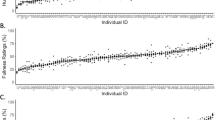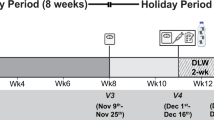Abstract
OBJECTIVE: Assessment of a possible relationship between habitual as well as manipulated meal frequency, blood glucose pattern, macronutrient- and energy intake (EI), and energy intake regulation in partially temporally isolated men.
DESIGN: A partially temporally isolated within-subject design assessing energy intake regulation in spite of intervention. Intervention consisted of manipulating meal frequency by offering iso-energetic (1 MJ) preloads high in fat or carbohydrate (CHO), with the same energy density. We have previously shown that after a high-CHO preload, inter-meal-interval was 1 h, while after a high-fat preload intermeal-interval was 2 h.
SUBJECTS: Twenty healthy young (18–31 y) normal weight (body mass index (BMI): 22.8±1.9 kg/m2) men.
MEASUREMENTS: On two separate days, each after a different preload: subsequent subjects' responses to the preload, eg manipulated meal frequency; continuous blood glucose levels and blood glucose patterns: macronutrient composition of food intake; EI; appetite ratings; and taste perception. From controlled 3-day food intake diaries: habitual meal frequency; EI; and macronutrient-intake.
RESULTS: Accuracy of energy intake regulation is expressed as minimizing the difference in energy intake, despite intervention. The difference in 24 h EI on the two test days after the preloads (r2=0.56; P<0.001) was a function of habitual meal frequency. Variation in energy intake was primarily explained by habitual meal frequency (r2=0.76; P<0.0001). Adding macronutrient composition and number of blood glucose declines to this increased the explained variation to 86 and 96%, respectively. Percentage energy from CHO or from fat explained the variation in habitual meal frequency (r2=0.84; P<0.0001). Adding the total number of blood-glucose declines to this increased the explained variation to 88%, and adding average baseline blood glucose levels, sweetness perception and hunger suppression during preload consumption increased the explained variation to 91%. Manipulated meal frequency was related to habitual meal frequency (r2=0.86; P<0.0001) and was a function of the number of transient and dynamic blood glucose declines (r2=0.74; P<0.0001).
CONCLUSION: Habitual meal frequency is of greater significance in energy intake regulation in healthy young men than manipulated meal frequency. Healthy young men with a high habitual meal frequency showed lower 24 h EI, and a smaller difference in EI after macronutrient specific preloads, compared to those with a low habitual meal frequency, thus showing a more accurate energy intake regulation. Habitual meal frequency is based upon a cluster of related factors including macronutrient composition of the food, sweetness perception, hunger suppression, blood glucose declines and average baseline blood glucose levels.
This is a preview of subscription content, access via your institution
Access options
Subscribe to this journal
Receive 12 print issues and online access
$259.00 per year
only $21.58 per issue
Buy this article
- Purchase on Springer Link
- Instant access to full article PDF
Prices may be subject to local taxes which are calculated during checkout


Similar content being viewed by others
References
Westerterp-Plantenga MS, Wijckmans-Duysens NEG, ten Hoor F . Food intake in the daily environment after energy-reduced lunch related to habitual meal frequency Appetite 1994 22: 173–182.
Drummond SE, Crombie NE, Cursiter MC, Kirk TR . Evidence that eating freqency is inversely related to body weight status in male, but not female, non-obese adults reporting valid dietary intakes Int J Obes Relat Metab Disord 1998 22: 105–112.
Speechly DP, Buffenstein R . Greater appetite control associated with an increased frequency of eating in lean males Appetite 1999 33: 285–297.
Speechly DP, Rogers GG, Buffenstein R . Acute appetite reduction associated with an increased frequency of eating in obese males Int J Obes Relat Metab Disord 1999 23: 1151–1159.
Fabry P, Fodor J, Hejl Z, Braun T, Zvolankova K . The frequency of meals: its relation to overweight, hypercholesterolaemia, and decreased glucose tolerance Lancet 1964 ii: 614–615.
Fabry P, Hejda S, Cerna K, Osoncova K, Pechor J, Zvolankova K . Effect of meal frequency in schoolchildren: changes in weight-height proportion and skinfold thickness Am J Clin Nutr 1966 18: 358–361.
Hejda S, Fabry P . Frequency of food intake in relation to some parameters of the nutritional status Nutrition Dieta 1964 6: 216–221.
Metzner HL, Lamphiear DE, Wheler NC, Larkin FA . The relationship between frequency of eating and adiposity in adult men and women in the Tecumseh Community Health Study Am J Clin Nutr 1977 30: 712–715.
Charzewska J, Kulesza W, Brzezinska J, Chwojnowska Z . Relationship between obesity or overweight development and the frequency of meals, their distribution during the day and consumption of atherogenic food products Zywienie Czlowieka 1981 8: 217–227.
Edelstein SL, Barrett-Connor EL, Wingard DL, Cohn BA . Increased meal frequency associated with decreased cholesterol concentrations; Ranco Bernardo CA, 1984–1987 Am J Clin Nutr 1992 55: 664–669.
Kant AK . Frequency of eating occasions and weight change in NHANES I Epidemiologic Follow-up Study Int J Obes Relat Metab Disord 1995 19: 468–474.
Summerbell CD, Moody RC, Shanks J, Stock MJ, Geissler C . Relationship between feeding pattern and body mass index in 220 free-living people in four age groups Eur J Clin Nutr 1996 50: 513–519.
Dreon DM, Frey-Hewitt B, Ellsworth N, Williams PT, Terry EB, Wood PD . Dietary fat: carbohydrate ratio and obesity in middle aged men Am J Clin Nutr 1988 47: 995–1000.
Bellisle F, McDevitt R, Prentice AM . Meal frequency and energy balance Br J Nutr 1997 77(Suppl 1): S57–S70.
Goris AHC, Westertrerp-Plantenga MS, Westerterp KR . Undereating and underrecording of habitual food intake in obese men: selective underreporting of fat intake Am J Clin Nutr 2000 71: 130–134.
Goris AHC, Westerterp KR . Improved reporting of habitual food intake after confrontation with earlier results on food reporting Br J Nutr 2000 83: 363–369.
Goris AHC, Meijer EP, Kester A, Westerterp KR . The use of a tri-axial accelerometer for the validity of reported food intake Am J Clin Nutr 2001 73: 549–553.
Dalosso H, Murgatroyd PR, James WPT . Feeding frequency and energy balance in adult males Human Nutrition: Clinical Nutrition 1982 36C: 25–39.
Wolfram G, Kirchbegner M, Mueller HL, Hollomey S . Thermogenese des Menschen bei unterschiedlicher Mahlzeithaeufigkeit (Thermogenesis in human subjects with differing meal frequencies) Am Nutr Metab 1987 31: 88–97.
Verboeket van de Venne WPHG, Westerterp KR . Influence of the feeding frequency on nutrient utilisation in man: conseqences for energy metabolism Eur J Clin Nutr 1991 45: 161–169.
Verboeket van de Venne WPHG, Westerterp KR . Frequency of feeding, weight reduction and energy metabolism Int J Obes Relat Metab Disord 1993 17: 31–36.
Verboeket-van de Venne WPHG, Westerterp KR, Kester ADM . Effect of the pattern of food intake on human energy metabolism Br J Nutr 1993 70: 103–115.
Melanson KJ, Westerterp-Plantenga MS, Saris WHM, Smith FJ, Campfield LA . Blood glucose patterns and appetite in time-blinded humans: carbohydrate versus fat Am J Physiol (Reg Integr Comp Physiol 46) 1999 277: R337–R345.
Herman PC, Polivy J . Restrained eating. In: Stunkard AJ (ed). Obesity Saunders: Philadelphia 1980 pp 208–225.
Stunkard AJ, Messick S . The three-factor eating questionnaire to measure dietary restraint, disinhibition, and hunger J Psychosom Res 1985 29: 71–83.
Ministerie van Welzijn, Volksgezondheid en Cultuur, en het Ministerie van Landbouw en Visserij . Wat eet Nederland. Resultaten van de voedselconsumptiepeiling 1987–1988. (What is eaten in The Netherlands. Results from food consumption surveys 1987–1988) Ministerie van WVC and Ministerie van L&V: Rijswijk 1988.
Westerterp-Plantenga MS, Pasman WJ, Yedema MJW, Wijckmans-Duijsens NEG . Energy intake adaptation of food to extreme energy densities of food by obese and non-obese women Eur J Clin Nutr 1996 50: 401–407.
Campfield LA, Smith FJ, Rosenbaum M, Hirsch J . Human eating: evidence for a physiological basis using a modified paradigm Neurosci Biobehav Rev 1996 20: 133–137.
Stichting Nederands Voedingsstoffenbestand, Dutch nutrient data base1993. Voorlichtingsbureau voor de Voeding, Information Office for Nutrition The Hague, The Netherland 1993.
Parker RE . Introductory statistics for biology 2nd ed. Edward Arnold/Camelot: Southampton, UK 1986.
De Castro JM . Behavioral genetics of food intake regulation in free-living humans Nutrition 1999 15: 550–554.
Melanson KJ, Westerterp-Plantenga MS, Campfield LA, Saris WHM . Blood glucose and meal patterns in time-blinded males, after aspartame, carbohydrate, and fat consumption, in relation to sweetness perception Br J Nutr 1999 82: 437–446.
Westerterp-Plantenga MS, Wijckmans-Duijsens NEG, Verboeket-van de Venne WPG, de Graaf K, van het Hof KH, Weststrate JA . Energy intake and body weight effects of six months reduced or full fat diets, as a function of dietary restraint Int J Obes Relat Metab Disord 1998 22: 14–22.
Westerterp-Plantenga MS . Analysis of energy density of food in relation to energy intake regulation in humans Br J Nutr 2001 85: 351–361.
Westerterp KR, Verboeket-van de Venne WPHG, Westerterp-Plantenga MS, Velthuis-te Wierik EJM, de Graaf C, Weststrate JA . Dietary fat and body fat: an intervention study Int J Obes Relat Metab Disord 1996 20: 1022–1026.
Kamphuis M, Lejeune M, Westerterp-Plantenga MS . Relative carbohydrate or fat intake is different between PROP-tasters and -non-tasters Int J Obes Relat Metab Disord 2001 25(Suppl 2): S7.
LeMagnen J . The metabolic basis of dual periodicity of feeding in rats Behav Brain Sci 1981 4: 561–607.
Mayer J . Regulation of energy intake and body weight, the glucostatic theory and the lipostatic hypothesis Ann NY Acad Sci 1955 63: 15–43.
Flatt JP . Is food intake regulation based on signals arising in carbohydrate metabolism inherently inadequate for accurate regulation of energy balance on high-fat diets? Behav Brain Sci 1981 4: 581–583.
Campfield LA, Smith FJ . Systemic factors in the control of food intake: evidence for patterns and signals. In Stricker EM (ed). Handbook of behavioral neurobiology: neurobiology of food and fluid intake Plenum: New York 1990 pp 183–206.
Woods SC, Strubbe JH . The psychobiology of meals Psychon Bull Rev 1994 1: 141–155.
Chapelot D, Aubert R, Marmonier C, Chabert M, Louis-Sylvestre J . An endocrine and metabolic definition of the intermeal interval in humans: evidence for a role of leptin on the prandial pattern through fatty acid disposal Am J Clin Nutr 2000 72: 421–431.
Author information
Authors and Affiliations
Corresponding author
Rights and permissions
About this article
Cite this article
Westerterp-Plantenga, M., Kovacs, E. & Melanson, K. Habitual meal frequency and energy intake regulation in partially temporally isolated men. Int J Obes 26, 102–110 (2002). https://doi.org/10.1038/sj.ijo.0801855
Received:
Revised:
Accepted:
Published:
Issue Date:
DOI: https://doi.org/10.1038/sj.ijo.0801855



